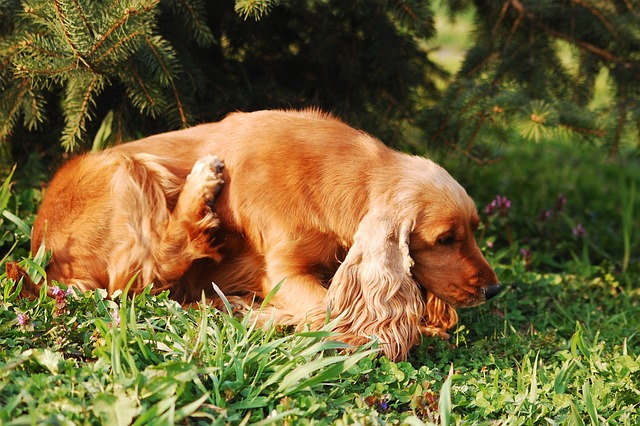
Fleas, those little blood-sucking parasites, are more than just an itchy annoyance for dogs and their owners. These pests can leave your furry friend miserable, causing health issues and even infesting your entire home.
Fear not, as this blog post will be your guide to identifying the signs of fleas on dogs and providing some helpful tips on removing and preventing their return!
Why Does My Dog Have Fleas?
Fleas on dogs are a common problem for pet owners, and if you’re dealing with an infestation, you might be wondering how your furry friend ended up with these pesky parasites. There are a few ways that dogs can get fleas, and understanding the causes can help you prevent future outbreaks.
Whether your pup likes to socialize at the dog park or you’ve recently brought home a new furry family member, exposure to fleas is a common risk. These tiny insects are skilled at jumping from host to host, so it doesn’t take long for an infestation to take hold.
Your pooch could also bring home a few extra pests through contact with flea-infested environments, such as bedding, carpeting, or upholstery. Flea eggs are hard to spot in carpeted spaces, and the larvae can hatch and mature quickly, leading to a full-blown infestation before you even realize what’s happening.
It’s important to clean and treat your pet’s living areas regularly and vacuum frequently to remove any potential flea eggs or larvae, especially if your dog spends much time outdoors. One of the top signs of fleas on dogs is dark black flea dirt on their fur or bedding, so be sure to keep these spaces clean!
Wild animals can also deposit fleas in your yard. Squirrels, raccoons, or feral cats infested with fleas can pass them onto your dog through accidental contact or even distribute these tiny pests throughout your lawn.
Limit your dog’s exposure to wild animals, and ensure your pet’s living areas are securely enclosed to prevent unwelcome visitors!
Signs of Fleas on Dogs
As a dog owner, a flea infestation is one of the most frustrating things you can deal with. These tiny, blood-sucking parasites can wreak havoc on your pet’s health and well-being, causing discomfort, irritation, and even leading to more serious health issues.
Fleas are tiny, but their impact can be massive. Besides their itchy bites, they could cause anemia, flea allergy dermatitis, and tapeworm infestations. Here are some common signs of fleas on dogs that you should watch out for:
- Excessive scratching, biting, or licking – Fleas cause itchiness and discomfort, and your dog may try to relieve it by scratching or biting at the affected area. You may also notice them constantly licking or grooming themselves.
- Red or irritated skin – Flea bites can cause redness, swelling, and irritation on your dog’s skin. Keep an eye out for open wounds or other serious inflammation in severe cases.
- Flea dirt or “flea poop” – Fleas leave behind tiny black or dark brown specks of their feces, commonly called “flea dirt.” You may find this on your dog’s skin or bedding.
- Visible fleas or eggs – Sometimes, you may see fleas or their eggs on your dog’s skin or fur. Fleas are small and move quickly, making them hard to spot. However, their eggs are easier to see as they are small, white, and oval-shaped.
- Hair loss or thinning – Chronic flea infestations can lead to hair loss or thinning in the affected areas. This is because excessive scratching and biting can damage the hair follicles and cause the hair to fall out.

If you notice any of these signs, it’s important to take action immediately to prevent the flea infestation from worsening. Contact your vet if your pup constantly struggles with severe flea infestations.
Prevention and Treatment for Fleas
Fleas are annoying and can be a real health hazard to your beloved pets. Knowing the signs of fleas on dogs can help, but remember to focus on treatment and prevention methods to keep your furry friend safe. Check out our tips here!
Use flea medication: Flea medication is one of the most effective ways to treat and prevent flea infestations in dogs. These medications come in different forms, such as topical treatments, chewable tablets, and collars. They kill fleas at various life cycle stages and prevent new infestations.
Wash your dog’s bedding: Who doesn’t like unwinding after a long day? Your dog’s bed is often their most used space, so it’s important to clean it frequently to remove any fleas or flea eggs. Wash it with hot water and a pet-safe detergent.
Vacuum frequently: Vacuuming your home often is another effective way to eliminate fleas. Be sure to vacuum all areas, including carpets, rugs, upholstery, and floors to remove any fleas, eggs, or larvae lurking in your home.
Treat your yard: Fleas can also live in your yard, so it’s important to treat your outdoor spaces as well. Innovative Pest Solution’s flea prevention and elimination services can lend a hand here!
Use flea traps: Flea traps are a great way to monitor flea activity in your home. These traps work by luring fleas with light and heat and trapping them on a sticky pad. This will help you determine your flea infestation’s severity and where they are coming from.
Remember, prevention is key when it comes to fleas. Keeping your dog clean, using flea medication, and regularly treating your home and yard are all crucial steps in preventing flea infestations. And whenever you notice the signs of fleas on your dog, don’t hesitate to get in touch with your veterinarian.
And when it comes to effective flea removal, it’s important to trust the experts at Innovative Pest Solutions to ensure that you and your furry friend can enjoy a flea-free home. Contact us today to learn more!





